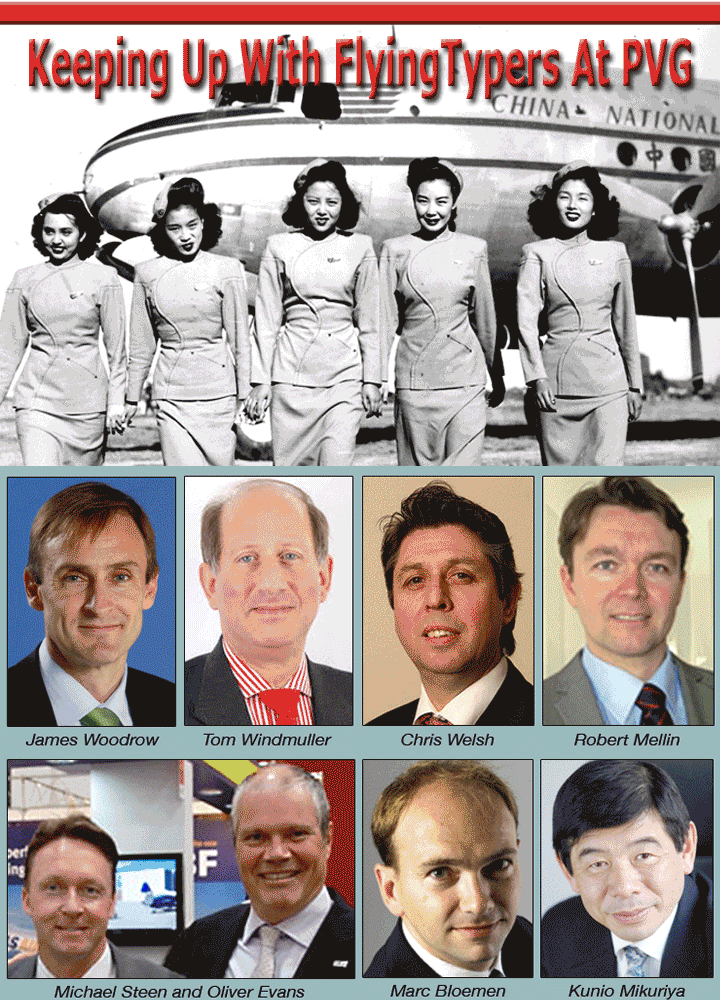
The
late Mayor of New York City Ed Koch loved to say to his constituents:
“How Am I Doing As Mayor?”
Sometimes hizzoner would get a glowing comment.
Other times he might be damned to hell.
We often get letters
about various topics we have covered, opinions expressed and even, at
times, heavy criticism of articles we have presented.
But rarely do we get
a reality check like this one.
J. Patrick Murray
is someone we are quite certain stands tall as the top IT guru in air
cargo today.
Smart, well spoken
and able to translate his thoughts in a manner instantly comprehensible
by all, Patrick, who heads up fast-growing CALOGI in Dubai, is a first-class
mind when it comes to attending, digesting and then regurgitating air
cargo session events.
 But
for IATA WCS, which took place in Shanghai early this month, Patrick tried
a different approach. But
for IATA WCS, which took place in Shanghai early this month, Patrick tried
a different approach.
You see, for many
of us—Patrick included—the event was too far away, too expensive,
or just too tough to juggle in terms of schedules.
So we asked Patrick
to read up on the four exclusive articles we wrote and published about
the event, which centered on the meetings and sessions, and then share
his evaluation (good and bad).
Here is the result.
Multilingual
Tracks
“I think that
this is a great idea. We all tend to take it for granted that business
is generally done in English. There are over 955 million Mandarin speakers
in the world and only 360 million English speakers, so one could argue
that the default should be that the proceedings are in Chinese with one
or two tracks in English. An interesting thought.”
Dangerous
Goods And The Threat To Air Safety
 “We
spend billions of dollars every year to ensure that passengers do not
inadvertently bring dangerous goods onto the aircraft through baggage
and carry on luggage screening. Thus, it is very difficult to inadvertently
carry dangerous goods onto an aircraft. Contrast and compare this to the
cargo industry, for instance: “We
spend billions of dollars every year to ensure that passengers do not
inadvertently bring dangerous goods onto the aircraft through baggage
and carry on luggage screening. Thus, it is very difficult to inadvertently
carry dangerous goods onto an aircraft. Contrast and compare this to the
cargo industry, for instance:
“He (Peter Hunt,
Airline Ground Safety manager for Cathay Pacific Airlines) did not fail
to emphasize at the very beginning of his presentation that ‘Lithium
batteries are everywhere’—and, especially in the case of Hong
Kong, this means they’re also in the mail, mostly undeclared, and
often counterfeit.
“The issue of
intentionally undeclared or mis-declared shipments by wilfully non-compliant
shippers was addressed by Mr. Hunt in no unclear words.
“I recently
read an article by Marie-Louise Morley on the AMSAFE website entitled
‘Playing with fire: Undeclared dangerous goods.’
“Written in
October 2011, it highlights that after nearly four years, the industry
still has some way to go to address the problem of undeclared dangerous
goods.
“The article
explains that goods sold via online auction and retail websites, such
as eBay, raise concerns that frequently neither the seller nor the buyer
has any understanding these are considered dangerous goods. These items
are then not declared as dangerous goods, are not properly identified,
are not safely packaged, and are not positioned in the aircraft in accordance
with dangerous goods regulations. Today, these goods represent the biggest
risk of fire in air cargo transportation, a risk that is increasing year-on-year
as the popularity of Internet trading grows.
“The article
continues that to compound matters further, there is no general consensus
within the industry on how to properly tackle the issue. While some advocate
educating consumers via the auction websites on the safe packaging of
dangerous goods, others believe in educating the actual shippers of the
products. There are others still who believe in a program combining increased
awareness and education, and stiffer penalties for those who do not adhere
to regulations.
“In the article,
Chris Wren, sales and marketing director of AMSAFE, agrees appropriate
training and education can help to address this problem. He also believes
the industry is running out of time.
“Following the
Boeing 747 freighter airplane accident on September 3, 2010, at Dubai
International Airport, the Federal Aviation Administration, Transport
Canada, and the United Kingdom Civil Aviation Authority initiated a study
to assess the magnitude of the potential threat to freighter airplanes
from onboard cargo fires. The report made for sober reading, revealing
that over the period 2011-2020 the predicted average number of cargo fire
accidents would be in excess of six per year.
“The good news
is there are solutions in the marketplace, as FedEx ably demonstrated
with the development of their pioneering main deck fire-suppression system
in 2009. This system is the industry’s first onboard automatic fire-suppression
system and is designed to provide heightened levels of safety during international
over-water flights.
“The highly
sophisticated fire suppression system features a network of infrared thermal
sensors, foaming agent generators and an overhead cargo-container injector
that can control and extinguish a fire in a container in minutes. Fire
blankets are also used to protect palletized loads. Current FAA regulations
require that aircraft depressurize, divert to the closest airport and
land immediately after any in-flight fire situation. This means the flight
crew has about 30 minutes to safely land the aircraft. With the new FedEx
safety system, aircraft on lengthy international flights, which can be
up to three hours from land, are able to safely divert and land.
“No doubt the
rise of undeclared dangerous goods is a frightening prospect, but it has
put safety high on many agendas. In some circles, safety is even considered
more serious than security issues, and now is the time to act. If we don’t
the potential consequences are unthinkable.”
Self Service
Kiosks
“This is a feature
that Calogi is currently developing. The target audience are the many
walk-in customers who deliver the one-off shipments here at Dubai Airport.
The aim is to avoid the need for walk-in customers to visit the dnata
counters, reduce the waiting times, increase the efficiency of the service,
and offer a variety of payment options. We are still in the requirements
stage and will delighted to share more information once it is operational.”
Putting The
iPad On The Forklift
“I’m very
much in favor of utilizing tablets (iPads) in industrial areas of the
air cargo business. Imagine conducting build up and breakdown activities
from a full manifest view and recording delivery and acceptance while
being able to add charges for additional/specialized services at the same
time.
“These devices
can be powered from the forklift battery with no need to keep replacing
and recharging the batteries. If they are detachable then all the better,
since they can be used to scan bar codes. Needless to say, if they are
detachable a good drop-resistance rating and crack-resistant screen are
advantageous. Tablets for use in warehouses and other forklift environments
should be rated to withstand repeated drops to concrete. Power management
is another important consideration. When computers are detached from forklifts
they run on their internal battery instead of the vehicle power supply.
It’s also worth looking at the total cost of ownership. Tablets
appear to be a lower-cost option, which is driving interest in the category.
When used on forklifts, the list price of a tablet can be significantly
different from its initial cost as it may be necessary to purchase Vehicle
mounts, AC-DC power converter and cables, battery chargers and extra or
replacement batteries, and a specialized dock with required interface
ports (serial, USB, power).
“An example
is the ePic Mobile Warehouse Management System, used by Cargo Airline
Services in the U.S., which uses an Apple iPad mounted on the forklift
to optimize the process between the documentation department and the warehouse.
The tablets are being used to electronically update cargo handling information
at the warehouse level and make it available, in real-time, to every party
in the logistic chain. While it can be argued the traditional handheld
terminals can be used to do the same, the screens have limited screen
size and can only be used for basic tasks, normally at a shipment rather
than flight or consolidation level. It’s time for the industry to
move forward.”
More Calls For Airfreight To Change
“Once again
a general consensus amongst participants and stakeholders regarding the
fact that airfreight needs to change, with the best solution being technological
innovation.
“Comments from
attendees included:
“‘It is
a fragmented and bureaucratic value chain,’ said Leif Rasmussen,
president and CEO of SAS Cargo. ‘If we don’t try to free ourselves
from this we will be in trouble.’
“‘There
is much more we can do,’ said Michael Steen, CCO of Atlas Air. ‘There
is lots of obsolescence in the supply chain and several areas need to
be addressed. Once we’ve done that we can increase market share.’
“‘The
only thing we can do is a total reinvention of processes. The mindset
needs to change. We need more radical thinking,’ said Oliver Evans,
chairman of TIACA.
“‘If we
can get the information to flow, weaknesses in air cargo would turn into
opportunities,’ Robert Mellin, the head of distribution logistics
for Ericsson, said. ‘But I don’t think you need to put in
more money. It’s a self-paying process. I don’t see this transformation
as something that will drive costs up, it will drive costs down.’
“Thilo Schäfer,
Vice-President Global Handling for Lufthansa Cargo, agreed that a cargo
cloud would be ‘the next step.’ He added, ‘I don’t
believe in messaging anymore.’
“[It’s]
interesting that the age-old concept of the Cargo Data Exchange, now renamed
the Cargo Cloud, is still being muted by many as a potential savior for
the industry. Given that airfreight shipments are around 1 percent of
global trade, a Cargo Cloud would need to host and disseminate information
relating to rail, sea, road (and drone?) shipments for this to become
an attractive proposition for the industry. It is not entirely clear how
this would really benefit airfreight versus other modes of transport.
Meanwhile, I imagine the integrators are looking at the traditional air
cargo industry with bemusement as another year passes.”
Geoffrey
|





